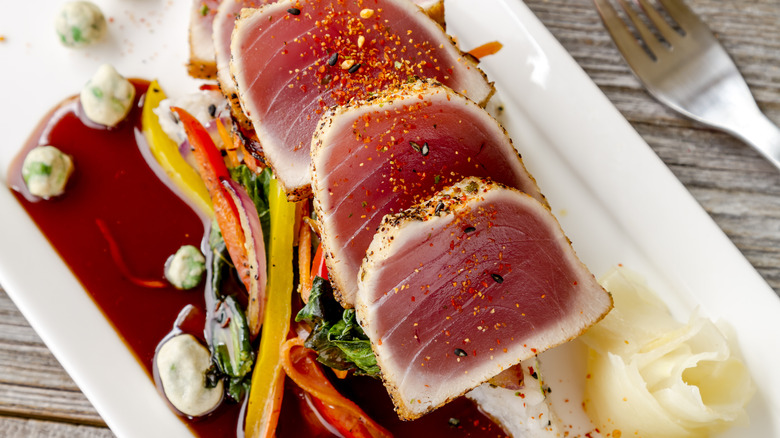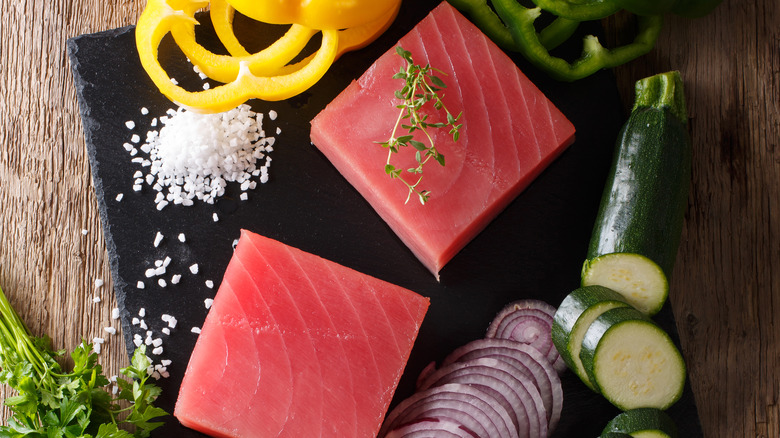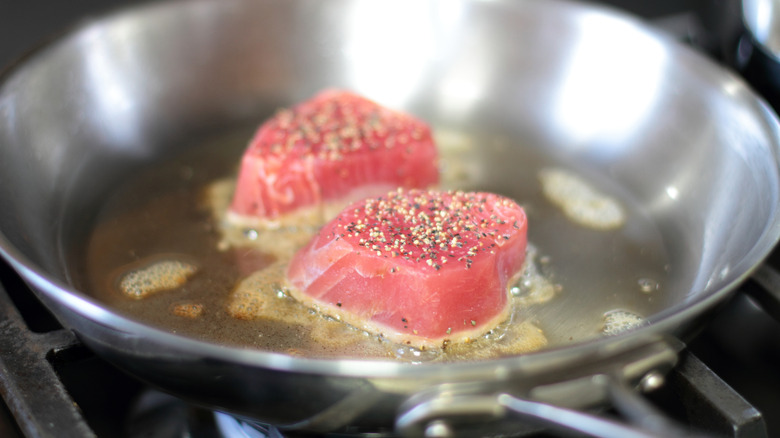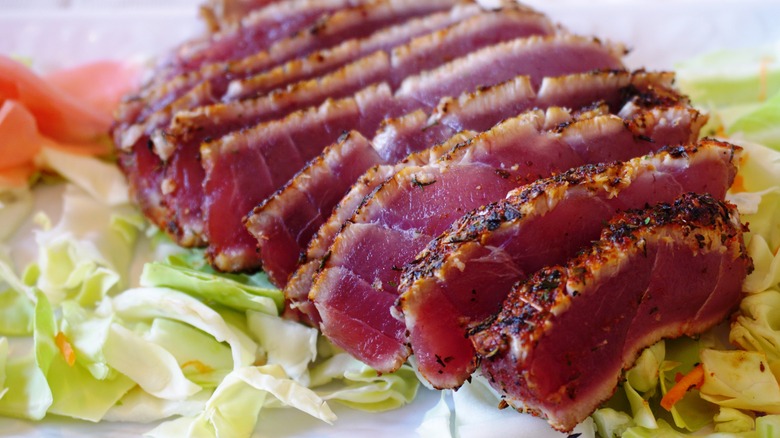Tips You Need To Get The Perfect Sear On An Ahi Tuna Steak
While some passionate home cooks may travel far to source ingredients that aren't local, there's a lot to be said for perfecting recipes and techniques for items that are easy to find and widely available. Tamari producer San-J explains that ahi tuna is one of those delicious ingredients that's both wonderful to work with and easy to source, whether fresh or frozen.
Ahi (aka yellowfin or bigeye) tuna can be served in a variety of dishes and preparations, from vibrant Hawaiian poke bowls featuring fresh cucumbers and jalapeños to earthy, sweet-savory tuna-mushroom skewers. Ahi tuna is also delicious served up simply, like as a seared tuna steak, though achieving that perfect sear may take a little practice. The last thing a cook wants is to ruin a lovely piece of ahi tuna, and there are a number of traps that can lead to disappointment on the plate. Fortunately, achieving the ideal sear isn't difficult if you follow a few best practices.
Season and marinate properly
Hawaii Seafood explains that ahi tuna has a mild flavor and a firm texture, which means that it's the perfect vehicle for a wide range of flavors and is suitable for serving raw, grilled, or seared. One technique for preparing your ahi tuna steak for searing is covering its sides in a combination of dry spices, like the paprika, thyme, ground black pepper, garlic powder, and onion powder featured in this blackened fish sandwich. If you're using dry spices, San-J recommends patting your ahi tuna steak dry before you season it.
If you're marinating your tuna steak — and especially if you're using ingredients that contain a lot of acid, like vinegar and citrus juice — it's important not to marinate your tuna steaks too long. About 15 to 20 minutes in the marinade will allow your chosen flavors to infuse the ahi tuna, while any longer may cause the acidic ingredients to begin to break down (i.e. cook) the fish, resulting in a tuna steak that's tough. Whether you choose dry spices or a marinade, both preparations are quick and easy, making ahi tuna steaks a great weeknight dinner choice that doesn't require much advance preparation.
Prepare your pan
San-J recommends using a sauté pan, while Straker Nutrition's recipe calls for the use of a cast iron skillet. Whichever style of pan you use, there's one cardinal rule for achieving the perfect sear on your ahi tuna steak: That pan must be hot! You also need a little oil to avoid your fish sticking to the pan, thus ensuring it will turn out perfectly seared. Choosing the right oil for pan-searing your ahi tuna steak is important; you'll want one with a high smoke point, meaning it can withstand high temperatures before it goes rancid. MasterClass recommends high-temperature sautéing with oils like avocado oil, olive oil, grapeseed oil, or canola oil, while unrefined oils like walnut oil or wheat germ oil should be absolutely avoided for pan-searing, as they have low smoke points.
To prepare the pan, you should get it good and hot, add the oil, and then heat it until the oil is almost at the smoking point. Once your ahi tuna steaks are seasoned and your pan is hot, you're ready to sear those steaks.
Timing is everything
Omaha Steaks points out, "The yellowfin tuna experience is best when most of the slice you're eating is uncooked." While a fat-marbled ribeye steak is rarely ruined by overcooking, lean ahi tuna steaks require more precision. San-J's recipe calls for placing the seasoned fish in the hot pan with hot oil for 45 seconds without moving the ahi tuna. Heat should then be reduced to medium and the tuna should cook for another 90 seconds. The steaks are flipped and cooked for a further two minutes for rare tuna, or a further three minutes for medium-rare. Straker Nutrition recommends a total cooking time of three minutes for rare and four minutes for tuna that's a little more done. In terms of timing, your tuna should be out of the pan in under five minutes, or you risk ending up with a tuna steak that's dry and tough.



